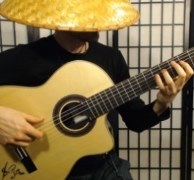Welcome to one of the most active flamenco sites on the Internet. Guests can read most posts but if you want to participate click here to register.
This site is dedicated to the memory of Paco de Lucía, Ron Mitchell, Guy Williams, Linda Elvira, Philip John Lee, Craig Eros, Ben Woods, David Serva and Tom Blackshear who went ahead of us.
We receive 12,200 visitors a month from 200 countries and 1.7 million page impressions a year. To advertise on this site please contact us.
|

|
|
Tarantos and Trananta
|
You are logged in as Guest
|
|
Users viewing this topic: none
|
|
Login  | |
|

   
Ricardo
Posts: 14875
Joined: Dec. 14 2004
From: Washington DC

|
 RE: Tarantos and Trananta (in reply to Kalo) RE: Tarantos and Trananta (in reply to Kalo)
|
|
|
they have, like most other palos, different meanings depending on context.
Cante-they both different cantes, meaning same form and family type but slightly different melodies and variations inside the general differences. A characteristic example of Taranto melody is that at the end of it, most singers sing an E# (half step below tonic) before the final note. Tarantas melodies don't have that, instead come down the scale to rest on tonic never below it. That is a generalization and small example. It takes lots of listening to begin to discern all the various details that distinguish all the cante de la mina family. Guitarist always play this for cante libre, or if there is compas a loose rhythm in 2/4 and only for Taranto, all the other cantes in the family are done free. Most of the time Taranto is interpreted free too.
Baile- at some point dancers started dancing "Taranto", it is similar feel to Tiento/tango rhythmically and the cante is forced to fit that slow 2/4 beat and structure. An essentially free cante ends up getting forced into that structure in numerous ways...I have yet to accompany two singers that do it EXACTLY the same rhythmically. Most oftent he melody of Taranto is done, but also I have heard taranta, minera, fandango minero, levantica, and cartageneras all forced into compas the same way or mixed in various ways to accomodate the choreography. As the dance builds, escobillas are accompanied same as tientos/tangos...typically tangos proper are sung later, even rumba to final, but it really depends on what the dancer wants. Despite all these variations the overall name used to describe the performance of the dance as a whole is simply "taranto".
Guitar- to keep it simple, the guitar plays in key of F# (unless some modern tuning is used to evoke the same "aire" this key has) and plays totally free or loose 3/4 type melodies for "Taranta" and if any compas of 2/4 or 4/4 is used, the moniker of "taranto" is used. Probably this started happening to solo guitar pieces AFTER the dancers starting dancing taranto.... the reason for the distinction to be used for a guitar solo should be obvious. Don't be surprised to find some totally free "taranto" guitar solos out there of course. It's not suposed to be THAT big of a deal.
Minera- this is a different cante melody in the family of cante de la mina, but when it comes to guitar solo, it refers again to free or loose melodies borrowing phrasing both in 3/4 or 2/4 at will, but in key of G# to differ from Taranta/taranto. To add confusion, ANY cante de la mina can be accompanied in G# OR F#...but when there is singing the cante melody is supposed to take over when naming it. In other words don't be surprised to find Taranto/taranta singing accompanied in key of G# as well...with or with out some rhythm need not make much difference.
To put it all into play in a single example.....Carmen Amaya's Queen of the gypsies recorded in the late 50s, she dances in 2/4, and sings a letra of Taranto, Sabicas plays in key of G# (por minera)....and the entire piece gets mislabled as "Rondeña".
Finally, they key of Granaina (B phrygian) can and has been used to accompany some cante de levante when the singer's range is very high pitched. I have heard taranto, taranta, cartegeneras all accompanied in those keys. Again, if it's a guitar solo it will simply be called "granaina". So for there has not been anything more then experiments that use granaina for baile...usually for only free interpretations or relating to Malagueñas. THe connective term for all these forms , malagueñas, granainas, cantes de la mina etc is "levante".
_____________________________
CD's and transcriptions available here:
www.ricardomarlow.com
|
|
|
|
REPORT THIS POST AS INAPPROPRIATE |
Date Jun. 18 2012 17:13:45
 |
|
 New Messages New Messages |
 No New Messages No New Messages |
 Hot Topic w/ New Messages Hot Topic w/ New Messages |
 Hot Topic w/o New Messages Hot Topic w/o New Messages |
 Locked w/ New Messages Locked w/ New Messages |
 Locked w/o New Messages Locked w/o New Messages |
|
 Post New Thread
Post New Thread
 Reply to Message
Reply to Message
 Post New Poll
Post New Poll
 Submit Vote
Submit Vote
 Delete My Own Post
Delete My Own Post
 Delete My Own Thread
Delete My Own Thread
 Rate Posts
Rate Posts
|
|
|
Forum Software powered by ASP Playground Advanced Edition 2.0.5
Copyright © 2000 - 2003 ASPPlayground.NET |
0.0625 secs.
|


 Printable Version
Printable Version










 New Messages
New Messages No New Messages
No New Messages Hot Topic w/ New Messages
Hot Topic w/ New Messages Hot Topic w/o New Messages
Hot Topic w/o New Messages Locked w/ New Messages
Locked w/ New Messages Locked w/o New Messages
Locked w/o New Messages Post New Thread
Post New Thread